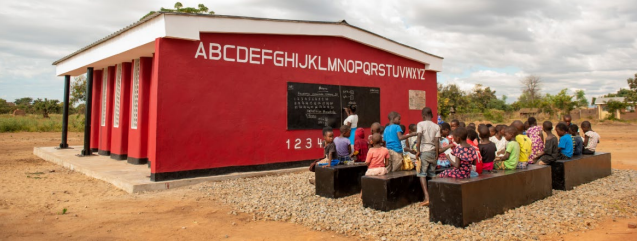- The students were installed on 21 June
- The school was printed in 18 hours, according to 14Trees and LafargeHolcim.
- Malawi's director of education impressed with school
- Africa has a huge deficit of schools and classrooms; 36,000 in Malawi alone, UNICEF says
- 14Trees wants to expand use of 3DCP technology in other African countries
Danish 3D construction printer company COBOD International A/S, makers of the printers that printed Europe's first one-, two- and three-storey buildings, is now also responsible for delivering the printer that made the world's first 3D printed school. The school in Malawi was 3D printed on a COBOD BOD2 printer by 14Trees, a joint venture between Lafargeholcim and CDC. Following the pre-announcement of a subsequent project, there have been many stories and articles about the construction of the world's first 3D printed school in Madagascar, but while that building has yet to be constructed, the Malawi school is already a reality.
Africa has a huge deficit of schools. UNICEF estimates that in Malawi alone there is a shortfall of 36,000 classrooms, which would take 70 years to build using conventional methods. According to 14Trees, this infrastructure deficit could be filled in as little as 10 years using 3D printing technology, which has been very well received in the country. Representing Malawi's Director of Education, Youth and Sports, Juliana Kuphanga Chikandila, Primary Education Advisor, said: "I am very impressed by the new building: its durability and design provides the space and facilities that pupils did not have before. This school will attract more pupils, and those who had left will come back to study".
Children have already started classes in the school with 3D printed walls, in just 18 hours, according to 14Trees. Miljan Gutovic, Head of Region Europe, Middle East and Africa for the LafargeHolcim Group, added: "I am very proud of the way our colleagues at 14Trees have used cutting-edge 3D printing technology to solve such an essential infrastructure need. Now that we have proven the concept in Malawi, we look forward to expanding this technology across the region, with projects already underway in Kenya and Zimbabwe."
The school in Malawi measures 56 m2 and was built using a COBOD BOD2 4-4-2 model, capable of printing concrete structures up to 10 metres long and wide, and 3 metres high.
The COBOD2 BOD2 printer used in Malawi was also behind the first 3D printed buildings in Europe, as well as the first 3D printed concrete wind tower made for GE. Henrik Lund-Nielsen, founder and CEO of COBOD, said: "We are proud to have been part of a new world first with this school in Malawi, after our printer realised the first 3-storey building printed on-site, and the first 3D printed wind tower for GE. These projects show that using our printers for small private homes is just the beginning, and that many more applications can be realised with the versatile technology of our printers. We look forward to continuing to work with 14Trees to help address the shortage of schools in Africa.
www.cobod.com
